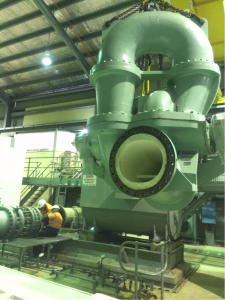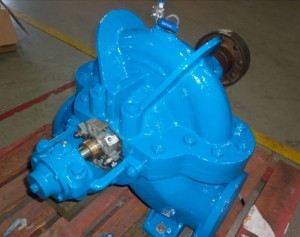Systems optimisation to improve efficiency
The overall efficiency of a pumping system is important for maintaining equipment reliability and lower operating costs. By looking at the system holistically, end users can decrease downtime and costs associated with extending equipment life such as lost production, maintenance and repairs.
Efficiency in pumping systems can be determined by comparing the amount of power a pump produces to the amount of power the pump is using. This has become increasing important as the cost of electricity continues to rise and end users seek to reduce costs.
Best efficiency point
 Pump systems should under best design practice not operate more than 10-15 per cent outside their best efficiency point (BEP).
Pump systems should under best design practice not operate more than 10-15 per cent outside their best efficiency point (BEP).
Although it is not uncommon for pump systems to be operating outside of their BEP due to the use of oversized or undersized pumps and variating process conditions. This results in excess energy usage, which causes surges, vibration, heat and noise, and leads to increased maintenance and energy costs due to shaft and seal problems, and cavitation, to name a few.
Another reason BEP is not maintained is due to a focus on the purchase price rather than lifecycle cost. While end users may purchase a pump that is cheap to buy and install, they need to balance it with the maintenance costs over the life of the equipment.
If a pump system is incorrect for the application, the cost of running it will increase due to excess energy usage and maintenance costs, resulting in higher lifecycle costs than if the correct pump was chosen.
One way to ensure pumps are running at BEP, reducing maintenance and energy costs, is pump systems optimisation.
Optimising systems for greater efficiency
Pump systems optimisation involves identifying, understanding and eliminating (in a cost effective manner) unnecessary losses while reducing energy consumption and improving reliability.
 It seeks to improve efficiency by looking at the pumping system as a whole, and how replacing one component can contribute to the increase or decrease of overall system efficiency. Therefore, in order to reduce energy consumption and cost, the entire system needs to be taken into consideration.
It seeks to improve efficiency by looking at the pumping system as a whole, and how replacing one component can contribute to the increase or decrease of overall system efficiency. Therefore, in order to reduce energy consumption and cost, the entire system needs to be taken into consideration.
Pump systems optimisation typically includes:
- Pre-screening: identifying problem areas
- Assessment: evaluation of the pump system
- Data collection: information is collected on current energy costs and pump systems compared with design conditions
- Lifecycle costing: improving profitability and reducing operating costs
- Benefits documentation: presenting finding to clients
Opportunities for improvement
 At FITT Resources we have a tank-to-tank system review approach. Our service team can provide end users with technical advice to help improve the efficiency of their pump system. They look for problematic areas and identify the best opportunities for improvement to suit individual project needs.
At FITT Resources we have a tank-to-tank system review approach. Our service team can provide end users with technical advice to help improve the efficiency of their pump system. They look for problematic areas and identify the best opportunities for improvement to suit individual project needs.
If there are areas that can be improved, including the replacement of inappropriate or worn equipment, our team can overhaul the system on-site, or, if it cannot be fixed on-site, it will be delivered to Fitt’s ‘in-house’ workshop. This increases efficiency by reducing the total cost of ownership through energy and maintenance savings.
For more information contact FITT Resources or visit https://fittresources.com.au/servicing/.
